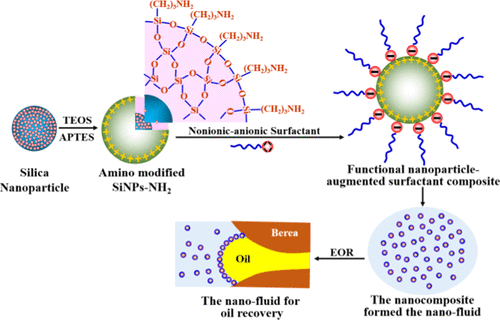当前位置:
X-MOL 学术
›
ACS Appl. Mater. Interfaces
›
论文详情
Our official English website, www.x-mol.net, welcomes your
feedback! (Note: you will need to create a separate account there.)
Surfactant-Augmented Functional Silica Nanoparticle Based Nanofluid for Enhanced Oil Recovery at High Temperature and Salinity.
ACS Applied Materials & Interfaces ( IF 8.3 ) Pub Date : 2019-11-27 , DOI: 10.1021/acsami.9b16960 Yanxia Zhou 1 , Xu Wu 1 , Xun Zhong 2 , Wen Sun 1 , Hui Pu 2 , Julia Xiaojun Zhao 1
ACS Applied Materials & Interfaces ( IF 8.3 ) Pub Date : 2019-11-27 , DOI: 10.1021/acsami.9b16960 Yanxia Zhou 1 , Xu Wu 1 , Xun Zhong 2 , Wen Sun 1 , Hui Pu 2 , Julia Xiaojun Zhao 1
Affiliation

|
Nanofluids in recent years have shown great potential as a chemical enhanced oil recovery (EOR) technology, thanks to their excellent performance in altering interfacial properties. However, because of the great challenge in preparing stable systems suitable for an elevated temperature and a high salinity environment, expanding the application of nanofluids has been greatly restrained. In this work, a novel nanofluid was prepared by integrating positively charged amino-terminated silica nanoparticles (SiNP-NH2) with negatively charged anionic surfactant (Soloterra 964) via electrostatic force. The resulted nanofluid could be stored at relatively high salinity (15 wt % NaCl solution) and high temperature (65 °C) for more than 30 days without aggregation. Successful coating of the surfactant on target SiNPs was verified by Fourier transform infrared spectrometry and the surface charge and size distribution. In addition, the potential of the nanofluid in recovering oil was investigated by analyzing the nanofluid/Bakken oil interfacial tension and the variation trend of the oil contact angle when brine was replaced by nanofluids. Experimental results showed that the water-oil interfacial tension of the Bakken crude oil decreased by 99.85% and the contact angle increased by 237.8% compared to the original value of 13.78 mN/m and 43.4°, respectively, indicating strong oil displacement efficiency and obvious wetting transition from oil-wet toward water-wet. Spontaneous imbibition tests conducted on Berea rocks showed that the nanofluid yielded a high oil recovery rate of 46.61%, compared to that of 11.30, 16.58, and 22.89% for brine, pure SiNP-NH2, and pure surfactant (Soloterra 964), respectively. In addition, when core flooding was applied, a total of 60.88% of the original oil in place could be recovered and an additional oil recovery of 17.23% was achieved in the chemical flooding stage. Moreover, a possible mechanism of the EOR using the nanofluid was proposed. Overall, the developed nanofluid is a promising new material for EOR.
中文翻译:

表面活性剂增强的功能性二氧化硅纳米粒子基纳米流体,可提高高温和盐度下的采油率。
近年来,由于纳米流体在改变界面特性方面的出色表现,其作为化学增强油采收率(EOR)技术已显示出巨大的潜力。然而,由于在制备适合于高温和高盐度环境的稳定体系中的巨大挑战,纳米流体的应用扩展受到了极大的限制。在这项工作中,通过静电作用将带正电荷的氨基末端二氧化硅纳米粒子(SiNP-NH2)与带负电荷的阴离子表面活性剂(Soloterra 964)集成在一起,制备了一种新型的纳米流体。所得纳米流体可以在较高盐度(15 wt%NaCl溶液)和高温(65°C)下储存30天以上而不会聚集。通过傅里叶变换红外光谱法以及表面电荷和尺寸分布证明了表面活性剂在目标SiNPs上的成功涂层。此外,通过分析纳米流体/ Bakken油的界面张力以及当用纳米流体代替盐水时油接触角的变化趋势,研究了纳米流体在采油中的潜力。实验结果表明,与原始值13.78 mN / m和43.4°相比,Bakken原油的水油界面张力分别降低了99.85%和接触角增加了237.8%,表明驱油效率高,驱油效果明显。从油湿到水湿的润湿过渡。在Berea岩石上进行的自吸实验表明,纳米流体的采油率为46.61%,高于11的采油率。盐水,纯SiNP-NH2和纯表面活性剂(Soloterra 964)分别为30%,16.58%和22.89%。另外,当进行岩心驱油时,在化学驱油阶段,总共可以采收原始油的60.88%,并实现了17.23%的额外采油量。此外,提出了使用纳米流体进行EOR的可能机理。总体而言,已开发的纳米流体是用于EOR的有前途的新材料。
更新日期:2019-11-28
中文翻译:

表面活性剂增强的功能性二氧化硅纳米粒子基纳米流体,可提高高温和盐度下的采油率。
近年来,由于纳米流体在改变界面特性方面的出色表现,其作为化学增强油采收率(EOR)技术已显示出巨大的潜力。然而,由于在制备适合于高温和高盐度环境的稳定体系中的巨大挑战,纳米流体的应用扩展受到了极大的限制。在这项工作中,通过静电作用将带正电荷的氨基末端二氧化硅纳米粒子(SiNP-NH2)与带负电荷的阴离子表面活性剂(Soloterra 964)集成在一起,制备了一种新型的纳米流体。所得纳米流体可以在较高盐度(15 wt%NaCl溶液)和高温(65°C)下储存30天以上而不会聚集。通过傅里叶变换红外光谱法以及表面电荷和尺寸分布证明了表面活性剂在目标SiNPs上的成功涂层。此外,通过分析纳米流体/ Bakken油的界面张力以及当用纳米流体代替盐水时油接触角的变化趋势,研究了纳米流体在采油中的潜力。实验结果表明,与原始值13.78 mN / m和43.4°相比,Bakken原油的水油界面张力分别降低了99.85%和接触角增加了237.8%,表明驱油效率高,驱油效果明显。从油湿到水湿的润湿过渡。在Berea岩石上进行的自吸实验表明,纳米流体的采油率为46.61%,高于11的采油率。盐水,纯SiNP-NH2和纯表面活性剂(Soloterra 964)分别为30%,16.58%和22.89%。另外,当进行岩心驱油时,在化学驱油阶段,总共可以采收原始油的60.88%,并实现了17.23%的额外采油量。此外,提出了使用纳米流体进行EOR的可能机理。总体而言,已开发的纳米流体是用于EOR的有前途的新材料。











































 京公网安备 11010802027423号
京公网安备 11010802027423号